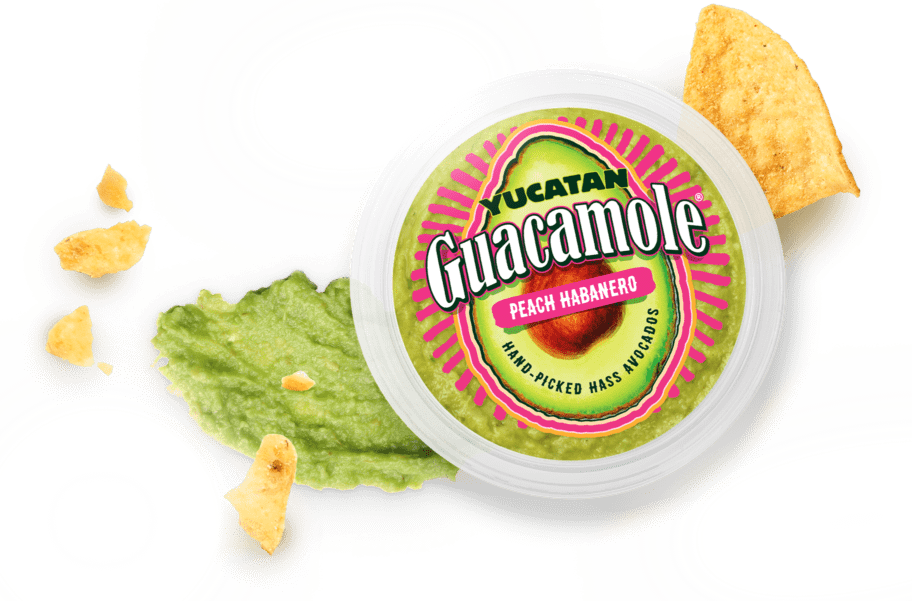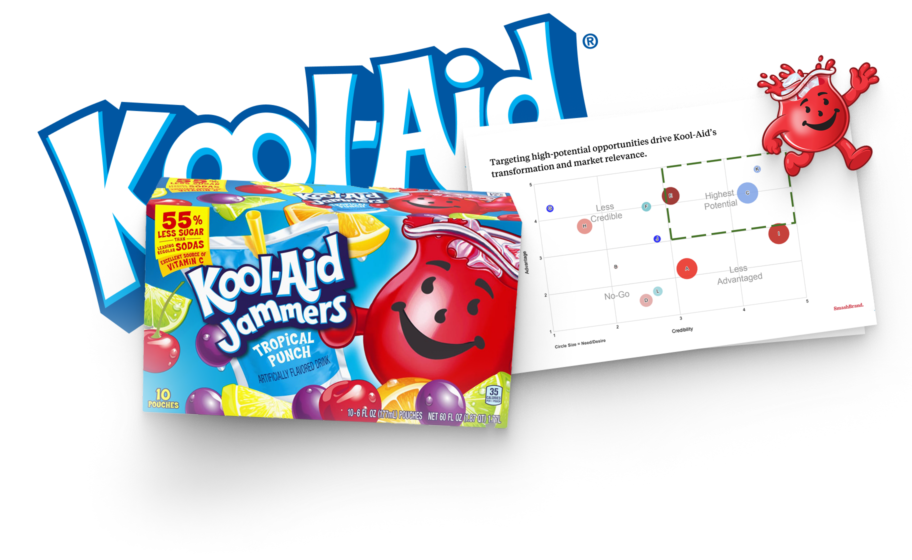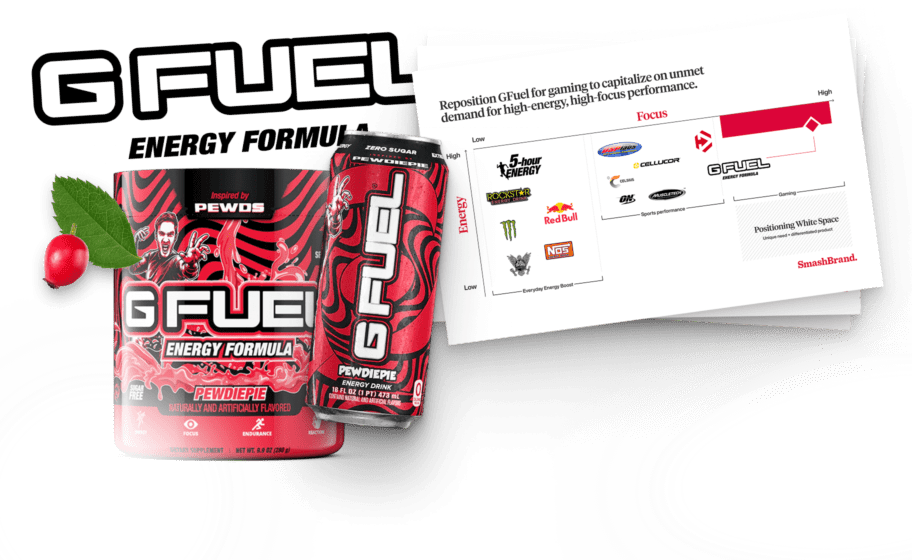Branding has evolved, but in today’s fast-paced market, it’s more essential than ever. CPG branding now requires brands to merge compelling visuals, messaging, and tone of voice with a constantly shifting consumer persona. A business that neglects its branding strategy risks losing ground to competitors who actively invest in its growth.
This article will show you how to build a CPG branding strategy that competes with industry leaders. As a CPG marketing agency with experience working alongside category giants and challengers, we’ll share exclusive insights to guide your approach.
You’ll discover the key elements of a branding campaign, how branding can strengthen or weaken your business, and the benefits of a strong CPG marketing strategy. We’ll also cover how to develop a practical branding approach, transition from strategy to activation, and measure the success of your CPG branding efforts.
What does branding include?
Understanding that your logo and visual identity play a crucial role in CPG branding campaigns may seem obvious, but many brands overlook their impact on overall brand performance. Companies in the consumer packaged goods industry must prioritize visual identity from the start, as it directly influences brand visibility and consumer perception.
However, branding extends far beyond aesthetics. If you want packaging that wins on shelf, your branding must encompass critical components such as:
- packaging design
- brand positioning
- brand messaging
- brand naming
- product naming
- brand guidelines
- marketing and advertising
- consumer experience
- Brand extensions and line extensions
While some of these elements are visual, messaging is just as important. The right brand strategy ensures that your brand’s messages resonate—not just in advertisements but also in consumer conversations and internal decision-making.
An effective CPG marketing approach integrates digital, social media, and email marketing to strengthen consumer connections and amplify marketing efforts. Partnering with a CPG marketing agency that understands brand management can help you craft a strategy that maximizes engagement and long-term success.
When executed strategically, branding doesn’t just create recognition—it builds loyalty, fuels growth, and sets your brand apart in the crowded consumer packaged goods market.
What Does Branding Impact?
Every decision you make will positively or negatively impact how consumers perceive your brand. At a top level, your choices significantly impact your brand identity. For example, my wife became very excited when she could purchase a Dunkin’ Donuts flavored protein. For her, Dymatize Nutrition went from an invisible brand to a front-and-center one.
My wife’s category entrance is an example of a marketing strategy that works, but let’s look at it from the perspective of someone familiar with the brand. They either:
- See Dymatize as more relevant and in touch with their interests.
- More interested in flavoring than producing a quality product.
Flashy flavors may turn off the old-school bodybuilder, but more people will try this protein due to its brand partnership (one of the rapidly growing CPG branding trends). This branding decision has changed its brand identity.
Your branding also affects your market position. Liquid Death’s branding choices made it stand out in the water aisle and become a top choice for concert venues. Liquid Death’s branding drives distinct brand positioning that has a home with consumers until they make a silly decision to shift away from their current differentiation.
How you are represented as a CPG company determines how your brand messaging resonates with consumers. It’s a relationship of duality, where one impacts the other. If consumers see you as the brand with flavor and spend all your time educating consumers on product quality, you create confusion in your branding.
So, to tie this all together, branding for consumer packaged goods impacts what you look like, what you say, and where you say it from. Conversely, it’s how consumers see, hear, and find you. A brand development agency can help you navigate this process from start to finish, covering every area in which branding plays a role.
The Benefits of Having The Right Branding Strategy
Admittedly, without the ability to quantify the benefits, it’s hard to tell if a branding strategy is genuinely effective or a byproduct that benefits because of the product or the marketing behind it.
For many companies, when consultants ask the question, “Is your branding strategy making a difference?” the answer is “I think so” or “I’m not sure.”
But it doesn’t have to be. Quantifying the impact on your CPG brand is possible when you make brand testing a part of your ongoing strategy. Now, assuming you can measure the impact of your branding campaign, here’s a look at the three most potent benefits.
Increased Brand Recognition
When a brand seemingly comes out of nowhere, we have branding to thank. Rarely does a brand go viral because of its magic ingredient or even its marketing of such magic. In almost every case, branding takes them from unidentifiable to recognizable.
Consumer Loyalty and Trust
Branding elements such as consistency and audience-centricity can deepen the relationship between the consumer and a CPG brand. Moving in the opposite direction, through our PackWords™, Preform Concept™, and Preform Purchase Intent™, we can identify where branding builds trust and, equally as important, where branding creates distrust.
Competitive Advantage
When competitiveness is considered a sport, it closely resembles track in that you are trying to distance yourself from the company behind you while inching closer to the competitor ahead of you. Effective branding accomplishes both.
Interestingly, for a CPG brand to increase market share, it needs to emphasize category distinction by honing in on a very targeted consumer persona. We live in a strange world where most of what becomes mainstream begins as a cult following, but that is our reality.
A strategic CPG branding campaign will identify what has the potential to go from niche to national.
How To Create Your CPG Branding Strategy
So what are the steps to creating impactful outcomes? CPG branding and strategy require a streamlined process that includes careful consideration, proper planning, and effective execution. Here’s a look at each of the main steps in a CPG branding strategy.
Market Research
Before you begin the creative process, you must know who you are creating for. Like any worthwhile relationship, you should start by asking questions, clarifying, and understanding. Market research accomplishes this objective.
By analyzing consumer preferences, trends, and competitors, you can understand your consumers, what they like, and how brands serve them. Market research for consumer packaged goods pays close attention to consumer behavior, which captures consumer insights more accurately than surveys and focus groups.
Through market research, we want to understand the target audience by what they do rather than what they say.
Brand Analysis
With an understanding of the CPG market and our target audience, it’s time to evaluate where we stand concerning consumer hopes and expectations. Understanding the current brand perception to identify its strengths and weaknesses helps us create a more streamlined branding strategy.
We identify these crucial metrics through the following:
As a brand strategy agency, we examine everything from current consumer demand to whether growth (or shrinkage) results from economic, category, or brand-specific efforts.
Defining Brand Outcomes
With clarity in hand, now is the time to define SMART outcomes for your CPG branding strategy. Since every brand strategy is different, what you include as a part of branding outcomes will differ, but here’s a list to get started. We’ve also created a downloadable worksheet for your team to use. You can find that here.
- Brand Recognition and Awareness
- Brand Differentiation
- Consumer Trust and Loyalty
- Market Share Growth
- Effective Communication
- Positive Customer Experience
- Brand Equity and Perceived Value
Crafting A Unique Value Proposition
If a consumer packaged goods brand cannot quickly define its point of value, how can we expect consumers to? To brand your UVP, you first need to have one. However, it is equally important to communicate your value proposition effectively through your branding efforts. Again, it’s a lesson in the duality of strategy.
Your brand value leads to brand differentiation, which leads to brand positioning. For a CPG product, they all live under the same umbrella, hoping to capture market share and further your brand footprint.
When you can brand your brand value proposition, you reduce stress in your marketing department’s life. Instead of trying to find points of differentiation, they can focus on pattern interruption and capturing attention.
So, how do you create a branding strategy around your unique value proposition? We’re glad you asked.
Brand Testing
CPG testing for brands is an underrated asset a company can use to impact revenues immediately. While testing is standard for marketing aspects, few brands leverage its power for branding.
CPG Brand testing consists of
- Brand Perception: How do consumers currently perceive the brand?
- Brand Identity: How easily can a consumer recognize a brand?
- Positioning and Differentiation: Do consumers see this brand as distinct in the marketplace?
- Target Audience Analysis: Identifying the target market based on who is the best fit for the brand.
- Pricing Analysis: Given the brand’s unique positioning and point of differentiation, what is the most optimal price?
- Message testing: Which words most resonate with the consumer
- Concept testing: Which retail packaging designs most appeal to the consumer?
- Purchase intent: How likely are consumers to purchase (not consider) a product?
- Brand Loyalty: How often do consumers return for a repeat purchase after the product trial?
It’s important to understand that these tests will have iterations; some may occur multiple times during brand development. For example, a pricing analysis may be needed after package design testing to determine how high a brand can price its product before it hits the ceiling.
Creating Brand Guidelines
Brand guidelines are crucial to your CPG branding strategy, ensuring consistency and coherence across all touchpoints. Brand guidelines provide:
- A framework for your brand’s visual representation.
- The tone of voice it should convey.
- The design principles for packaging.
Logo and visual elements play a significant role in brand recognition, and guidelines establish rules for their usage, such as size, placement, and color variations.
The tone of voice defines your brand’s personality and language to communicate with consumers, guiding the messaging and creating a consistent brand identity.
CPG packaging design guidelines also ensure a cohesive look and feel, reflecting your brand’s values and appealing to the target audience. Creating comprehensive brand guidelines empowers your team to maintain a solid, recognizable brand presence that resonates with consumers.
Shifting From Development To Activation
While the majority of the effort in creating your branding strategy occurs during the brand development phase, the real power of your strategy occurs during activation, including your go-to-market strategy and ongoing sales and marketing campaigns.
During activation, you must remain true to your brand guidelines while allowing for the differences across each channel. For example, a new opportunity arises to further your CPG marketing campaign on a new social media channel. But, only some of your brand elements will fit on this text-dominant platform. Which elements do you retain, and which are OK to set aside on this platform?
Every brand faces this challenge, and they should address these concerns during the development phase. Creating a hierarchy of brand elements and purchase drivers is vital for understanding what stays and what goes.
Another critical point during the activation phase is to ensure your brand communication matches the overall branding strategy. Brand representation should be consistent throughout your employees and every visual touchpoint the consumer experiences.
An important touchpoint is influencer marketing. With influencer marketing a big part of today’s CPG industry, brands must pay attention to how their influencer relationships impact their branding.
The last point on activation that we must bring up is the overall level of engagement a brand has and the experience it provides. CPG brand experience is critical in today’s dominant digital marketing world. CPG companies that are heavy on advertising and silent on social have a net negative effect on their branding because consumers crave brand relationships.
Whether through content marketing or another form of forward-facing organic communication, a CPG marketer needs to understand the role of their organic efforts in the branding campaign’s totality.
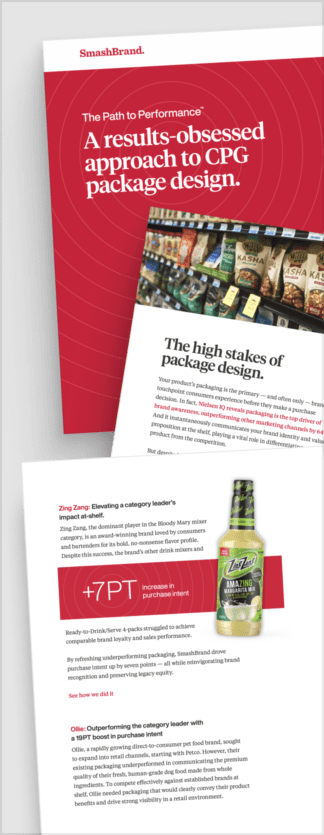
Path to Performance™
Taking a results-obsessed approach to CPG package design.
Learn how SmashBrand’s proprietary process – rooted in scientific principles, informed by data, and validated by your target audience – takes the guesswork out of package design and delivers guaranteed results.
Measuring and Evaluating Branding Performance
The process of measuring and evaluating brand performance is crucial to ensure the effectiveness of your CPG branding strategy. To assess the impact of your branding efforts, you can follow these key steps:
- Identifying key performance indicators (KPIs): CPG KPIs define specific metrics that align with your branding objectives, such as brand awareness, customer loyalty, market share, and consumer perception.
- Monitoring brand awareness and perception: Regularly track and analyze brand recognition, recall, and reputation indicators. Utilize surveys, social media monitoring, and consumer feedback to gauge how the target audience perceives your brand.
- Tracking sales and market share: Measure the impact of your branding strategy on sales performance and market share. Analyze data on product performance, consumer purchase behavior, and competitor analysis to assess the effectiveness of your brand in driving business growth.
- Gathering consumer feedback: Engage with your customers to understand their experiences and opinions about your brand. Use customer surveys, reviews, and focus groups to gain insights into their perception, satisfaction, and loyalty.
- Making adjustments and improvements: Based on the data and feedback collected, identify areas for improvement and make necessary adjustments to your branding strategy. Continuously iterate and optimize your approach to align with evolving consumer preferences and market dynamics.
By implementing these steps, you can effectively measure and evaluate your brand’s performance, enabling you to make informed decisions and drive the success of your CPG branding strategy.
CPG Branding Tips
If you are looking for additional tactics specific to consumer goods that will set your brand apart both in your process and visual identity, here are three tips that will help.
Carefully Consider Your Retail Partnerships
They say that you are the five people you most associate with. That may also be true in your retail execution. A branded product whose primary channels include Walmart, Dollar Tree, and Grocery Outlet is branding itself as a discount brand.
Whether through a traditional retailer or ecommerce, you want to choose your retail partners carefully rather than saying yes to them all. Even the competitors who sit next to you on a physical or digital shelf will impact how consumers perceive your brand.
Be Proactive With Crisis Management
Be sure to have branding-specific crisis management to address situations that may interfere with brand loyalty. Every brand faces a pivotal moment when its response to an unforeseen situation pushes customer loyalty upward or downward.
Reputation is an integral part of branding, as it’s what people think about when they see your visual identity. Sometimes, it requires a single statement, whereas other times, a brand transformation is necessary to address a deep consumer concern.
Engage In Brand Storytelling
While branding is sometimes considered a single statement, in many cases, effective branding occurs during longer-form consumption. Creating a brand story is a critical part of a CPG marketing strategy but also for branding.

Nice Package
Don’t miss out on our monthly newsletter Nice Package!
Each month, we deliver a data-driven newsletter directly to your inbox, unpacking a critical topic in the FMCG & CPG industry.
"*" indicates required fields
Data-Driven Brand Development For CPG Brands
SmashBrand is a brand development agency for FMCG and CPG companies. From brand strategy to packaging design testing, our Path To Performance™ process guarantees a retail performance lift. Book a time to discuss your project with our team.
Subscribe to
Nice Package.
SmashBrand’s Nice Package: Stay current with our latest insights
Free Resource.
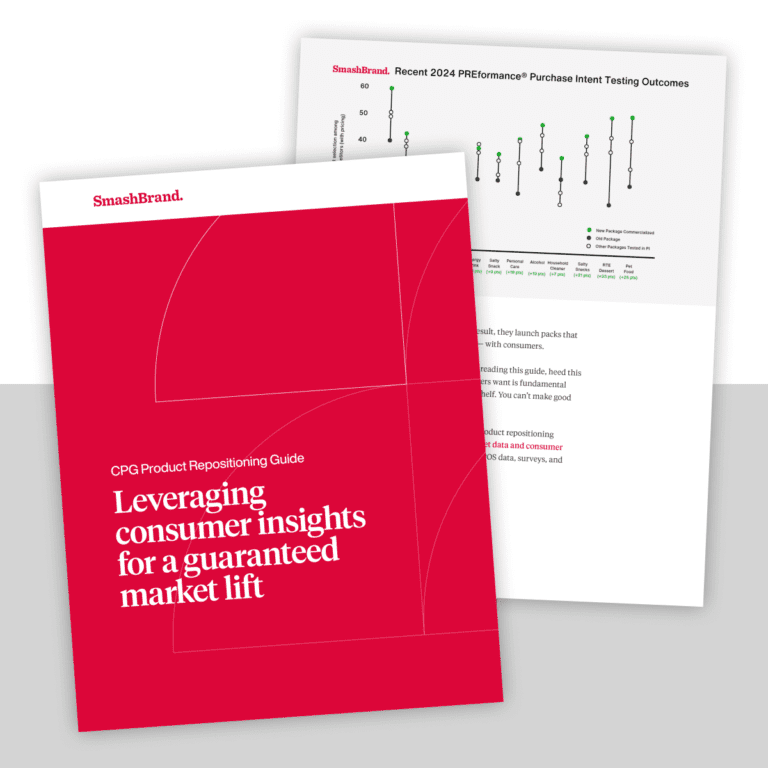
CPG product repositioning guide.
Explore the five undeniable signs your CPG product needs repositioning along with strategies for leveraging consumer insights for a guaranteed market lift.
Download Whitepaper About CPG product repositioning guide.


